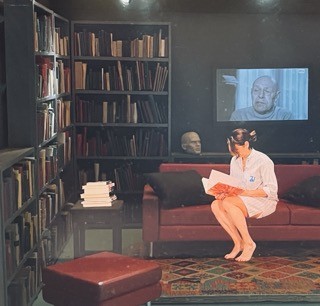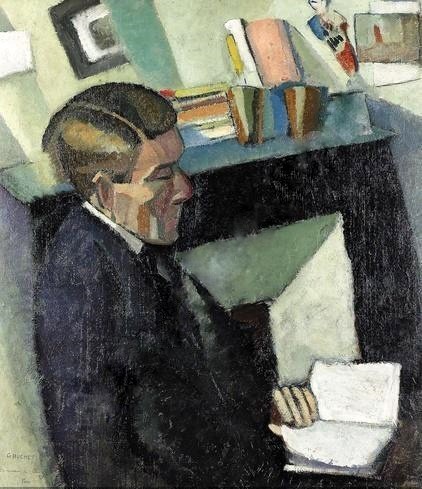Blast from the Past: First published on January 4, 2020. Usually my Blasts from the Past are older than this one. However, it seems worthwhile to reissue this now for two reasons. First, Schutz & Rainey, 2020 published a wonderful analysis of modeling (Reading Teacher) about the same time this blog first appeared. They emphasized showing, situating, and abstracting -- with a strong focus on the "invisible parts" of reading (what we do inside our heads). Nice piece of work. Second, and, perhaps, more urgent is the fact that with so much distance teaching going on modeling appears to be more in fashion than ever before. In a classroom the teacher might just tell kids to do something without a demonstration -- figuring that they'll be able to fix any problems with careful observation of the students' attempts. That is a less plausible approach at a distance. That makes modeling more important today than it was last January. To model well, we need to show students how (including the invisible parts), situate these demonstrations in familiar contexts (so kids know when to use the model), and abstract the models (pulling the processes apart into steps with clear labels). Whether your focus at the moment is on decoding or comprehension, modeling is a valuable aspect of quality teaching. Good luck.
Teacher question:
What do you think about “modeling” in literacy instruction?
Shanahan’s reply:
Tyler’s mom sent me the video. It was riveting.
Like many 21st century parents she had a camera going in the nursery at naptime. And, the camera revealed something pretty cool during an afternoon nap.
Tyler was a toddler. He had started day care recently, the youngest kid there.
Now he was in his crib and supposed to be sleeping. But Tyler had his book and was jabbering away.
He wasn’t pretending to read so much as he was pretending to read to a group of kids. He’d hold up the book with the pictures facing out and, unmistakably, with the rhythm and cadences of an adult reading a picture book to children, he’d babble for each page.
Back in the 1960s, social psychologist, Albert Bandura, pioneered the study of observational learning. He figured out that a great deal of human behavior was learned from… well, from watching what other humans did.
That might seem obvious, but it appears to be anything but when one views classroom literacy teaching. One study (Ros, 2009) conducted 170 hours of observation of 20 teachers and found only one example of a teacher modeling her thinking during reading.
Of course, when children observe adults, they do what Tyler did, they imitate or re-create the visible physical behaviors. That’s why it’s so easy for my grand-daughter, Olivia, to brandish her light sword like Princess Leia or move like a ballerina after the Nutcracker. Golfing, batting, vacuuming, fighting and so on all entail lots of imitable physical behaviors.
Reading and writing do, too, but external behaviors aren’t the important part of what we teach about literacy. That’s where mental modeling or metacognitive modeling comes in. Research (e.g., Palincsar, 1986) has supported the idea of using think alouds to reveal to learners what is going on cognitively during reading and writing – an idea long incorporated in direct or explicit instruction (Pearson & Gallagher, 1983; Reutzel, et al., 2013; Rupley & Blair, 2009).
Such cognitive modeling has a place to play in developing print awareness and book reading behaviors (the things Tyler focused on), but it can help with decoding, oral reading fluency, reading comprehension strategies, and writing processes, too. Which is why it’s troubling that modeling is used so rarely and so poorly in literacy teaching.
One ubiquitous example of teachers thinking they are providing a powerful model for student imitation is what is often referred to in lesson plans as “model reading.” You know, a teacher read aloud. Now, don’t get me wrong. I don’t oppose teachers reading to kids, but if the idea is to improve kids’ reading fluency – as many teachers claim – then it’s poor modeling.
Let’s first quibble over the terms, “models” or “modeling.” Personally, for teaching, I prefer to talk about “demonstrations,” not models. “Model” seems less intentional or insistent than demonstration. Models seem passive to me – you may or may not imitate them. But demos are more about trying to put an idea across to someone – like teaching.
When I was learning ballroom dancing, my inability to observe and interpret sequential movement was an embarrassment. My teacher would show me what to do, and I’d respond with bizarre moves. She’d then stand next to me, facing the same direction so I’d not need to reverse her movements in my head, and we’d try again, often as clumsily as before. Sometimes it was so bad that she literally got down on hands and knees and moved my feet herself. She wasn’t passively hoping I’d see her movements as a model and try to ape them. No, she was trying to teach me to dance, and demonstration was an important tool in her toolbelt.
Researchers have found that students with dyslexia often have trouble learning sequential actions because of their own difficulties with observation (Menghini, et al., 2011). That suggests the possibility that some kids might struggle to follow your literacy demonstrations as much as I did with the foxtrot.
How can we use demonstrations most effectively to teach reading?
One valuable insight is to tip kids off as to what they are to notice prior to a demonstration (Andrieux & Proteau, 2016). Whether I’m to learn how the letters get connected in handwriting, or how to choose which of my brainstormed topics is the best one to use for my composition, or what happens to the reader’s voice when the sentence ends with a question mark, the demo is likely to be most effective when the observers know what to watch or listen for. (And, general attention matters, too. Don’t get so involved in your demonstration that you don’t notice that the kids are looking out the window. Make sure eyes and ears are focused on the demonstration… it’s called observational learning for a reason).
Another thing that can help is to segment the demonstration into smaller steps. Observational learning can be blocked by cognitive overload. If there is too much information coming in, then there will be too little learning. That’s why so-called “model reading” doesn’t improve student fluency, there is simply too much information for students to be able to remember and transferring such a demonstration to different text will be a bridge too far for many kids.
When I’m showing kids how to read fluently, I limit my demonstrations to a single sentence, and then have the students try to read that same sentence. More than that overburdens their memories. Perhaps you may want to provide an overall model, “Boys and girls, I’m going to read this page or this chapter to you, and I want you to notice how I read it. What do I sound like?” and so on. But, if you want kids to actually try to read like that, now you need to work with smaller segments that the students are going to try themselves, and memory plays a big part in that kind of performance.
The teaching sequence is demonstration, prompt, practice. You demonstrate the process or action that you want students to duplicate, then you put them in a situation in which they can try to do that, and then you provide guidance and support as they practice the behavior. Thus, when a youngster is trying to read the text fluently, and he or she goes chopping through a sentence disfluently, I’ll stop them, demonstrate what that sentence should sound like, and then have them try it themselves.
Many teachers have gotten the idea demonstrations aren’t that important, that it is better for kids to learn by doing. Even when teachers do model for their students, it is often a one-time affair. When teaching comprehension strategies, the teacher may show students how to predict or self-question on day one, but that will be the last demo of that information those kids are going to see. However, a study with ninth graders found that when it came to writing, observation was more effective than learning-by-doing (Couzijn, 1999). Deliberate practice matters, but students often don’t know what to practice and that’s where demonstrations come in.
In my fluency example, it sounded so simple. The student reads a sentence badly, I show him how it should be done, and then he can do it himself. That happens sometimes, but other times, the youngster’s second reading is more like my dancing. I may have to show him again, perhaps telling him what to pay attention to this time or reading only the first clause instead of the whole sentence. Demonstrations and re-demonstrations should be a usual part of your teaching.
Some teachers and parents fear that if kids see or hear something that isn’t correct that the errant info will be permanently imprinted in their brains. That, for instance, puts some off the idea of “invented spelling,” in which kids try to write as well as they can without looking up words in the dictionary or asking others how they are spelled.
However, when it comes to observational learning, research has shown repeatedly that expert models aren’t as powerful as the opportunity to contrast expert and flawed models (Rohbanfard & Proeau, 2011). Thus, having kids comparing their spelling attempts with the correct spellings can help, as can having them compare audiotapes of their oral reading with an expert model. When I demonstrate oral reading fluency, I sometimes give flawed examples myself, reading too fast or too slow, skipping words, mispronouncing, droning on in a monotone and the like. The kids will tell me what’s wrong with my demonstration… “It’s too bumpy,” they point out when I pause too long between words.
Research is clear that observational learning is valuable and that there are ways teachers can use demonstration more effectively than others. Coaching can improve modeling (Davis, et al., 2018), unfortunately, not all teachers have expert coaches available to help them improve their teaching quality.
If you want to get good at demonstrations, rehearse! I know demonstrating can appear easy, but practicing can really help. Rehearsal will help you to reduce unnecessary information, prevent confusion, and divide the task up sensibly. It can help identify what students should be told to watch for.
Demonstration fits into reading instruction in lots of places. I’ve already given several oral reading fluency examples. But demonstrations are appropriate for other aspects of literacy instruction, too. For example,
1. Print awareness and concepts of print
When teachers read aloud big books, they can demonstrate directionality, return sweeps at the ends of lines, or what happens at the end of a page. Pointing to the words may give kids a clue as to what is being read and can helps kids develop concept of word.
2. Decoding
Often, we teach phonemes and spelling patterns, but without sufficient guided application in sounding out words. Studies have shown that teaching kids to “blend” improves the effectiveness of phonics teaching (Pflaum, 1980), and I suspect at least part of this benefit is from the decoding demo it provides. Demonstrations can show children what good readers do when stuck on an unknown word (and, no, it isn’t look at the picture and guess).
3. Comprehension strategies
Research shows that teaching students to summarize, self-question, bring prior knowledge to bear, visualize, and so on are beneficial. Studies also show that “gradual release of responsibility” is a particularly effective way to teach (Shanahan, et al., 2010). In this approach, a teacher demonstrates the mental moves she is going to make during reading, then gradually has the students imitate these moves; the “I do it, we do it, you do it” approach.
4. Writing processes
Teacher demonstrations can play a big role in teaching kids how to plan their writing, how to draft, revise, and edit.
Demonstrations should be a regular occurrence in your teaching. Try to make those demonstrations as powerful and effective as you can.







Comments
See what others have to say about this topic.